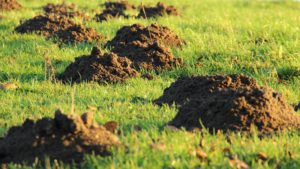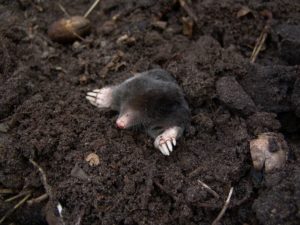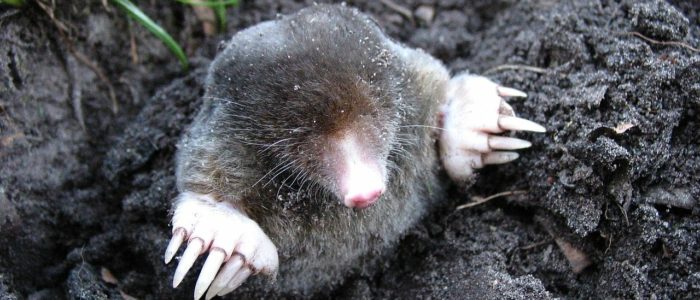Moles. They’re small, furry, and make for adorable sidekicks in cartoons. But in real life, they can cause a lot of damage to your lawn and their molehills can cause injury to livestock.
Biology and Tunnels
Moles are small, furry, solitary wildlife that range from 4.4 – 7 inches in length, not including the tail. Their long claws allow them to burrow through dirt with ease, and they can dig up to 18 feet of tunnels per day! Their tunnels are normally two inches in diameter, but a male will expand his tunnels when searching for a mate. After mating, the mole will make a bed chamber off of one of their tunnels lined with dried plant material. They also have food storage chambers where they store worms. They keep them immobile by biting off their heads. Before a mole eats the worm, it will squeeze the dirt and other matter from its gut so it does not ingest the dirt.
As far as mating goes, a male mole, or a boar, will mate with a female (also known as a sow) anywhere between the months of February and May. May is a very late mating period though, and most moles will mate by April. According to LiveScience.com, the gestation period for a litter of mole pups is approximately 4-6 weeks. The sow will give birth to 3-4 hairless pups. These pups will start to grow hair at 14 days old, and will be weaned from their mother by 4-5 weeks of age. Soon after they are weaned, they will leave the nest, and after that, they leave their mother and home tunnel completely.

What do moles do to your lawn?
Moles are responsible for raised, ridged areas of your yard that give way when you step on them. They can also be held accountable for piles of dirt that come from seemingly nowhere. Respectively, these are the mole’s surface tunnels and entryways. Moles also dig deep, though. Their tunnels can range from two inches underground to 5 feet underground! These tunnels can be pretty damaging to a lawn or garden as it disrupts the roots of plants, but typically, moles are not responsible for eating your plants. Voles are tiny vegetarian mice that can overtake mole tunnels, and they might be the ones responsible for eating your plants.
For most of us, the biggest issue a mole will cause is unsightly damage to your lawn and garden, but for farmers, it’s a different story. Molehills create holes in the ground and a large animal like a cow or a horse can easily step in one and break their leg. This may cause the farmer to put the animal down which can be very costly.
What do moles eat?
Moles eat insects and grubs, but they especially love to eat earth worms! They will eat their weight in food everyday. Some people will try to eradicate moles by eradicating earth worms, but earthworms can actually be very beneficial to your lawn. Earthworms eat decayed plant matter and other organic material which makes their waste or “worm castings” very good fertilizers. The presence of earthworms in your soil is also an indication of healthy soil since there is enough nutrients to support the earthworms.
Earthworms are also natural aerators. They can loosen compacted soil, and further churn already loosened soil. The burrows and tunnels they create are responsible for the aeration and loosening of the soil, and they eat anything they come across. They then carry their waste to another section of the ground which helps to evenly spread inorganic and organic matter. However, sometimes earthworms aren’t enough. It is possible your soil isn’t healthy enough to support these creatures which means you need to add something your soil to make it healthier. Compacted soil can cause bald patches in your yard and can also be the source of drainage problems.

How can I get rid of moles or prevent them?
Preventing moles can be difficult. You could cut back on your lawn and opt for ground cover like rocks or clay that is not appealing to any creature, insect and mammal alike. Keeping earthworms and other insects at bay will also keep moles at bay. According to a Gregory entomologist, you should keep your yard rolled and packed to discourage moles. Soil that is compact is less attractive to these critters. You could also consider partnering with a pest management company, but even for them, the practice of mole removal can be inconsistent. When asked about a mole problem, our entomologists always ask what is surrounding the yard. If the home is in a subdivision with sidewalks surrounding the home, it will yield more consistent results than a home that is situated next to a golf course on a wooded lot. In areas like these, mole control is a practice that reaps very inconsistent results. Our entomologist stated the biggest issues moles cause for homeowners is the disruption of grass roots which dries the grass out. This creates an unsightly line of dead grass. He recommended keeping your grass watered to try and lessen any damage the moles might cause.

